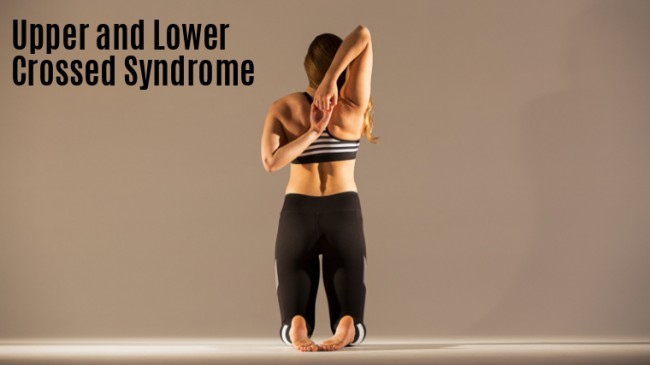Upper and Lower Crossed Syndrome

In my last blog, I wrote about the kinetic chain and how one joint can affect other joints along the kinetic chain. I also talked about how the soft tissue surrounding the joint, such as muscle, ligament, tendon, and the joint capsule need to be considered when addressing the kinetic chain. A good example of this is something called the “Crossed Syndrome.” There are separate crossed syndromes for the upper body and lower body. In a nutshell, crossed syndrome refers to tightness in one area leading to weakness in other areas, which can affect posture and overall joint function and mobility.
Upper Crossed Syndrome
Upper Crossed Syndrome (UCS) refers to muscle imbalance that happens in the shoulder and neck. The muscles that are tight in the UCS are the upper trapezius and levator scapula, which both elevate the shoulder blade, crossed with tightness of the pectoralis major and minor. With this tightness, there is also muscle weakness in the deep neck flexors and the lower trapezius. The following picture demonstrates this:

So what does this all mean and how does this affect our body? UCS can lead to a slumped/slouched posture. As seen in someone with a hunchback, their shoulders are rounded forward and they have an increased curve in their mid-back. Also, you will notice they have a forward head. This can be problematic because for every inch forward, the head weighs an extra 10 pounds! Imagine your little neck muscles trying to hold up 20 pounds all day while working on the computer or texting on the phone. That can be very fatiguing and cause problems in your neck, shoulders, and sometimes down the arms. It’s no wonder these postural changes can affect the long-term health of your joints and overall well-being. With the shoulder blades in such a poor position, the mechanics of how the shoulder moves changes completely. There are 18 muscles that attach to the shoulder blade and with the shoulder blade being out of place, all 18 muscles are affected. Muscles that are supposed to move the shoulder a certain way cannot fire, and other surrounding muscles will have to compensate. This repetitive overcompensation can lead to shoulder instability, neck and arm pain, RTC dysfunction, and degeneration of the joint cartilage.
Lower Crossed Syndrome
Lower Crossed Syndrome (LCS) is very similar to the upper crossed syndrome except that it involves the pelvis. Like UCS, LCS is a result of imbalances in the lower segment. In LCS, the muscles that are short and tight are the hip flexors and low back extensors, which will cause weakness to the abdominals and the gluteus maximus. The following picture demonstrates LCS:
As the picture shows, tightness in the hip flexors crosses with tightness in the low back extensors, and weakness in the abdominals crosses with weakness in the glutes. Similar to UCS, these imbalances in muscle length and strength can lead to less than optimal position of the pelvis. This imbalance results in an anterior tilt of the pelvis, increased bending of the hips, and a compensatory over extension of the low back. This posture tends to overstress both hip joints, as well as the lower back, and often leads to compensatory tight hamstrings. The picture below is a typical presentation of someone with LCS:
This bad positioning of the pelvis adds a lot of stress to the low back and makes it difficult to stabilize the core. If your core is unstable, this can lead to a host of musculoskeletal injuries.
So what can we do to prevent Crossed Syndrome? The solution is easy. Just stretch and release the muscles that are tight, and strengthen the muscles that are weak. The links below will guide you through some releases and exercises you can perform.
For Upper Crossed Syndrome
Pec release: https://www.youtube.com/watch?v=SzCRaqMBjXI
Upper trap and Levator scap release: https://www.youtube.com/watch?v=Q3YW8Pfv0Jk
Banded A’s and W’s: https://www.youtube.com/watch?v=FhL-paLvISc
Chin tucks: https://www.youtube.com/watch?v=KGvEkY7tnAs
For Lower Body Crossed Syndrome
Hip flexor release: https://www.youtube.com/watch?v=LOmkCNoSQN8
QL Release: https://www.youtube.com/watch?v=O_0yB5DWFmk
Glute Bridges: https://www.youtube.com/watch?v=44q8gv9HsEQ
Planks: https://www.youtube.com/watch?v=kOfTwarkoXo